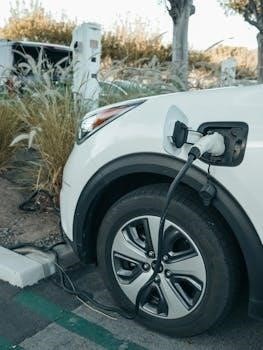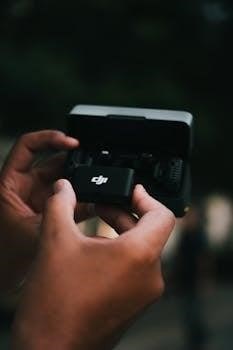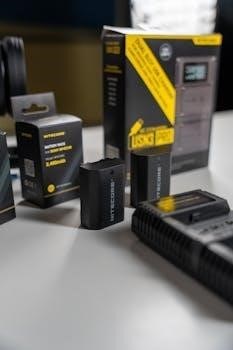DieHard Battery Charger Manual⁚ A Comprehensive Guide
This comprehensive guide provides instructions for safely using your DieHard battery charger and engine starter. Discover how to prepare your battery, understand safety precautions, and troubleshoot common issues for optimal performance.
DieHard battery chargers are designed to efficiently charge and maintain various types of automotive batteries, including lawnmower, motorcycle, and small car batteries. These chargers often feature multiple charging stages and automatic shut-off capabilities for optimal battery care. Models may include features like engine start assistance, battery and alternator testing, and LCD voltage indicators. Always prioritize safety by adhering to guidelines and using proper eye and body protection, ensuring your charger operates with a functional cord and plug. DieHard chargers combine power and safety for reliable performance.
Understanding DieHard Charger Models
Exploring the diverse range of DieHard battery chargers involves understanding model-specific features. Each model has unique functionalities. Familiarizing yourself with these ensures proper usage, efficient charging, and prolonged battery life for various applications.
Identifying Your Specific Model Number
To ensure you’re using the correct manual and instructions, locating your DieHard battery charger model number is crucial. This number is typically found on a sticker or plate affixed to the charger’s housing. Common locations include the back, bottom, or side panel of the unit. The model number is essential for accessing specific product information, warranty details, and compatible replacement parts through online resources such as Sears Parts Direct. Correct identification streamlines troubleshooting and ensures proper maintenance of your device, maximizing its lifespan and performance.
Key Features and Specifications
DieHard battery chargers offer a range of features tailored to different battery types and charging needs. Models like the DieHard 71341 include smart charging technology, automatically adjusting the charging rate for optimal battery health. Some chargers feature multiple charging stages and microprocessor control for fully automatic operation. Engine start capabilities, such as the 50-amp engine start function, provide quick boosts for starting vehicles with dead batteries. Other key specifications include voltage compatibility (6V/12V), amperage settings (2A trickle charge to 10A or higher), and rugged metal case construction for durability.
Safety Precautions
Prioritize safety when operating a DieHard battery charger. Always wear eye and body protection. Ensure proper ventilation. Never operate with damaged cords. Refer to the manual for detailed guidelines to prevent accidents and injuries.
General Safety Guidelines
Before using your DieHard battery charger, carefully review all safety instructions in the owner’s manual. Always wear safety goggles and protective clothing to prevent contact with battery acid. Ensure the charging area is well-ventilated to avoid build-up of explosive gases. Do not operate the charger with a damaged cord or plug. Have a qualified service person replace damaged components immediately. Disconnect the charger from the power source before connecting or disconnecting the battery. Keep children and pets away from the charging area to prevent accidents. These precautions ensure safe and effective operation.
Avoiding Eye and Body Contact with Battery Acid
Battery acid is corrosive and can cause severe burns, so protecting yourself is crucial. Always wear safety goggles and protective clothing, including gloves, when working with batteries. If battery acid splashes into your eyes, immediately flush them with copious amounts of clean water for at least 15 minutes and seek immediate medical attention. For skin contact, thoroughly wash the affected area with soap and water. Neutralize any acid spills with baking soda and water solution. Never touch your face or eyes while handling batteries to avoid accidental contamination. These precautions minimize the risk of injury.
Charging Procedures
Follow these steps to safely charge your battery. This section covers preparing the battery, connecting the charger correctly, and selecting the appropriate amperage for optimal charging. Ensure proper ventilation during the charging process.
Preparing the Battery for Charging
Before connecting your DieHard charger, ensure the battery is ready for charging. First, disconnect the battery from the vehicle to prevent electrical damage. Clean the battery terminals with a wire brush to remove any corrosion, ensuring a good connection. Verify the battery’s voltage to determine the appropriate charging rate. Always wear safety goggles and protective clothing to avoid contact with battery acid. Make sure the area is well-ventilated to dissipate any gases produced during charging, minimizing the risk of explosion or fumes. Consult your vehicle’s manual for any specific instructions related to battery charging.
Connecting the Charger to the Battery
Properly connecting your DieHard charger is crucial for safe and effective charging. Begin by attaching the red clamp to the positive (+) terminal of the battery. Ensure a firm grip for optimal conductivity. Next, connect the black clamp to a clean, unpainted metal surface on the vehicle’s frame, away from the battery and fuel lines. This provides a reliable ground. Double-check that the connections are secure before plugging the charger into a power outlet. Avoid reverse polarity connections, as this can damage the charger and battery. Follow the specific instructions in your DieHard charger’s manual for your model.
Selecting the Appropriate Charging Rate (Amperage)
Choosing the correct amperage setting on your DieHard battery charger is vital for effective and safe charging. For small batteries, like those in lawnmowers or motorcycles, use the 2-amp trickle charge setting to prevent overcharging. For standard car batteries, a 10-amp setting is generally suitable for regular charging. If you need a quick boost to start your engine, the 50-amp engine start setting can provide a temporary surge. However, avoid using this setting for extended periods. Always consult your battery’s specifications and the DieHard charger manual to determine the optimal charging rate for your specific battery type and condition.

Troubleshooting Common Issues
Encountering problems with your DieHard battery charger? This section addresses common issues such as the charger not working or the battery failing to charge. Find solutions and tips for diagnosing and resolving these problems.
Charger Not Working
If your DieHard battery charger isn’t powering on, first ensure it’s properly plugged into a functioning 115-volt outlet. Inspect the power cord for any damage, and if found, have it replaced by a qualified technician. Check the continuity with a multimeter. Verify the circuit breaker’s functionality. A failed circuit breaker can prevent the charger from receiving power. Also, confirm that the charger’s internal components haven’t malfunctioned, potentially requiring professional repair or replacement. Ensure proper connection to bare metal. Check the user manual for specific troubleshooting steps related to your model.
Battery Not Charging
If your DieHard charger indicates that the battery isn’t charging, first confirm the clamps are securely connected to the correct battery terminals – red to positive and black to negative. Ensure the battery isn’t sulfated or severely damaged, potentially preventing it from accepting a charge. Select the appropriate charging rate based on the battery type and size, using a lower amperage for smaller batteries. Some chargers have auto shut-off. Check the connections and settings. Refer to the manual for recommended settings. Check the battery voltage indicator. If issues persist, the battery itself may need replacement.

Maintenance and Storage
Proper maintenance and storage are crucial for prolonging the life of your DieHard battery charger. This section outlines the correct procedures for storing your charger and maintaining the cord and plug for safety.
Proper Storage Procedures
To ensure the longevity and optimal performance of your DieHard battery charger, proper storage is essential. Always disconnect the charger from both the battery and the power source before storing it. Store the charger in a clean, dry environment, away from moisture, direct sunlight, and extreme temperatures. Coil the cords neatly to prevent damage and tangling. Keep the charger out of reach of children and animals. Consider storing it in its original packaging or a protective case to prevent dust accumulation and physical damage during storage. Regular checks during storage are advisable.
Cord and Plug Maintenance
Maintaining the cord and plug of your DieHard battery charger is crucial for safe and reliable operation. Regularly inspect the cord for any signs of damage, such as cuts, fraying, or exposed wires. Do not use the charger if the cord is damaged; have it replaced by a qualified service person immediately. Ensure the plug is securely attached to the cord and free from damage. Avoid pulling the charger by the cord when disconnecting it from the power outlet; instead, grasp the plug firmly. Keep the cord clean and free from dirt and debris. Store the cord neatly to prevent kinks and tangles.

Warranty Information
DieHard offers a warranty on its battery chargers. Refer to your product’s documentation for specific warranty details, including coverage period and terms. Keep your purchase receipt as proof of purchase for warranty claims.
DieHard Warranty Details
DieHard battery chargers typically come with a limited warranty covering defects in materials and workmanship. The warranty period can vary, so it’s crucial to consult the specific warranty information included with your charger. This warranty usually applies to products operated and maintained according to the provided instructions. If a defect arises during the warranty period, DieHard may offer repair or replacement options. Always retain your purchase receipt as proof of the original purchase date for any warranty claims. Contact Sears Parts Direct or the appropriate customer service channel for assistance with warranty inquiries.

Where to Find Manuals and Support
Find DieHard charger manuals and support through online resources, including Sears Parts Direct. Download PDF manuals, access product information, and get assistance with troubleshooting and warranty claims for your DieHard battery charger.
Online Resources and Downloads
Access a wealth of information for your DieHard battery charger online. Many resources offer downloadable PDF manuals, providing detailed instructions and troubleshooting tips; Websites like Manualzilla and Sears Parts Direct often host manuals for various DieHard models. Search using your specific model number (e.g., 71222, 28.71219, or 28.71323) to find the correct manual. These online resources can provide specifications, safety guidelines, and warranty information. Always verify the source’s credibility before downloading any files to ensure accurate and safe usage of your charger.
Sears Parts Direct
Sears Parts Direct is a valuable resource for finding replacement parts and support documentation for your DieHard battery charger. Even if your charger is no longer actively listed, Sears Parts Direct may still provide access to manuals, parts diagrams, and troubleshooting information. Search by your DieHard model number to locate specific components. They carry millions of appliance parts and more. This can be useful for identifying the correct replacement cord or other components. Check the product number to see if it is still active and get product information.
